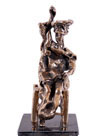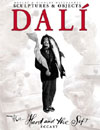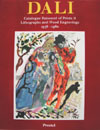|
|
 |
 |
|
 |

|
 |
Salvador
Dalí
born
in Figueres, Catalonia, in 1904, died 23 January 1989, Figueres
(Spain)
His
father was a free-thinker and agnostic who quoted Voltaire and had
a volatile temper. Later in life he was to become a Roman Catholic
and a Republican.
In
1907, his sister, Ana Maria was born. The young Salvador was the
only young male in a female-dominated household, where his over-protective
mother, grandmother, aunt and nurse cosseted him. He was prone to
tantrums and self-induced coughing fits and, in order to upset his
father, deliberately wet the bed until the age of eight, when he
discovered that he could upset him more by bad behaviour at school...Read
more
|
|
 |

|
|
 |
 |

| |
|
|
|
|
|
|
|
|
| |
|
|
 |
|
| |
|
|
  |
|
|
|
| |
|
|
|
|
|
|
| |
DALI
Symbolism
The
elephant is also a recurring image in Dalí's works. It first
appeared in his 1944 work Dream Caused by the Flight of a Bee around
a Pomegranate a Second Before Awakening. The elephants, inspired
by Gian Lorenzo Bernini's sculpture base in Rome of an elephant
carrying an ancient obelisk, are portrayed "with long, multijointed,
almost invisible legs of desire" along with obelisks on their
backs. Coupled with the image of their brittle legs, these encumbrances,
noted for their phallic overtones, create a sense of phantom reality.
"The elephant is a distortion in space," one analysis
explains, "its spindly legs contrasting the idea of weightlessness
with structure."I am painting pictures which make me die for
joy, I am creating with an absolute naturalness, without the slightest
aesthetic concern, I am making things that inspire me with a profound
emotion and I am trying to paint them honestly." —Salvador
Dalí, in Dawn Ades, Dalí and Surrealism.
The
egg is another common Dalíesque image. He connects the egg
to the prenatal and intrauterine, thus using it to symbolize hope
and love; it appears in The Great Masturbator and The Metamorphosis
of Narcissus. Various animals appear throughout his work as well:
ants point to death, decay, and immense sexual desire; the snail
is connected to the human head (he saw a snail on a bicycle outside
Freud's house when he first met Sigmund Freud); and locusts are
a symbol of waste and fear...Read
more
|
|

| |
Illustrated
books & catalogs
|
 |
 |
 |
DALI
- The Hard and the Soft. Sculptures & Objects.
Catalog of the three-dimensional work of Dali,
by Robert and Nicolas Descharnes, published by Eccart edition, France
in 2003, 285 p.
This
book is the first work dedicated exclusively to Dali, the sculptor
and visionary. The artist's tridimensional work is shown in 683
illustrations, complete with information relative for each one,
and a special description of the bronze sculptures.
Read
more
|
| |
|
|
|
 |
|
 |
 |
 |
 |
 |

|
 |
| |
|
|
|
|
|
|
|
|
| |
|
|
 |
|
| |
Bibliography:
|
|
|
|
|
|
| |
2016
Jean-Luc Pouliquen, Dali, son mécène et le président,
CIPP.
2012 Thierry Dufrêne, Double image, double vie, Paris,
Hazan, 280p.
2008 Jean-Pierre Thiollet, Carré d'art. Barbey d'Aurevilly,
Byron, Dalí, Hallier, Croissy-sur-Seine, Anagramme éd.
2007 Astrid Ruffa, Philippe Kaenel, Danielle Chaperon (éd.),
Salvador Dalí à la croisée des savoirs, Paris,
Éd. Desjonquères.
2006 Jean-Gabriel Jonin, Jours intimes chez Dalí,
Rafael de Surtis-Editinter.
Read
more
Monographs
& catalogs available
|
|
| |
|
|
| |
|
|
Engravings etchings aquatints lithographs serigraphs silkscreen graphics watercolor drawings sculptures bronze ceramics posters art books jewels
|
|
|
|
|